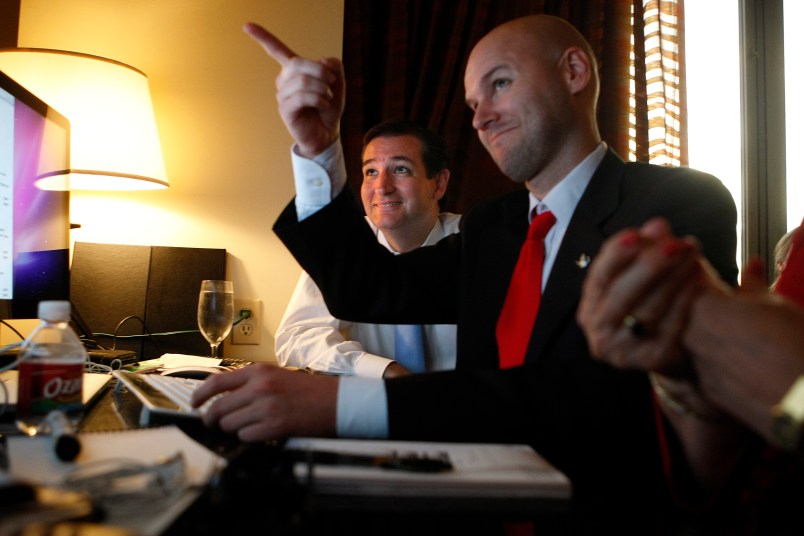You don’t go to campaign operatives for impartial opinions. You don’t even really expect them to tell the truth. But sometimes when one says something that is not only clearly false but demonstrably false, it merits correcting the record. So let’s return to the point about this document which lists Ted Cruz’s mom, Eleanor, as a Canadian citizen and eligible voter in 1974. As I noted on Friday, the existence of the document does not prove that Cruz was a Canadian citizen (human error is always possible). Nor does it necessarily negate her son’s eligibility to run for President. But I was struck that the Cruz campaign felt compelled to respond to the document’s existence by making claims that are simply demonstrably false. I’m talking specifically here about the statement Cruz chief campaign strategist provided to Breitbart.com.
Johnson said that “the document itself does not purport to be a list of ‘registered Canadian voters … All this might conceivably establish is that this list of individuals (maybe) lived at the given addresses. It says nothing about who was a citizen eligible to vote.”
Well, this is clearly, clearly not true. The Breitbart.com article appeared to be worked out with the campaign to assure people that the document had no significance. So they made no effort to rebut the statement. But in the interests of helping everyone know the details. This statement is clearly and demonstrably false. And here’s why.
First, lets look at the statute governing the compilation of the list. The statute clearly and repeatedly states that these are lists of qualified voters for federal elections compiled for the purposes of administrating elections for the House of Commons. And note: Canada Elections Act of 1970, Rule 18 …
Each pair of urban enumerators shall a) exercise the utmost care in preparing the list of electors for the polling division for which they have been appointed; and b) take all necessary precautions to ensure their list, when complete, contains the name, occupation and address of every qualified elector [i.e., voter] in the polling division for which they have been appointed and does not contain the name of any person who is not so qualified.
Second, listen to the account of current Canadian election officials.
According to the director of election operations and communications for Elections Alberta (the province where Calgary is located), here’s how the lists were assembled in the early 1970s (emphasis added)
So when they [would] knock on doors, they ask them: are you Canadian citizens, are you 18 years of age or older, and are you a resident in this facility and how long have you been living here? If they meet all that criteria then they add them to the list, take their name and addresses and anyone else who’s living there. And they ask, is anyone else living here a Canadian citizen 18 years of age or older? And if they are, then they take their names from them at the door. And that’s the way it worked in those days.
Finally, since publication we received an email from TPM Reader EW who provided a contemporary anecdotal account which matches up with the statute and the description of the current Canadian elections official …
I lived in Canada at the time and taught Canadian politics (and other things including mathematical modeling and social statistics at York University in Toronto).
Enumerators were selected by political parties. They worked in teams of two – one selected by the party that had won the riding (district) in the previous election and the other by the 2nd place party. They did go door to door. The voters list was compiled and posted WITHIN 1000 ft of the homes of the people on the list – on a tree or a pole etc or in the lobby of an apartment building. It was very easy to correct mistakes (a court of revision which sound big deal but was nearby and simple to access. Mainly it was folks left of). Once enumerated, you got a slip (like an old-fashioned receipt). At the time, enumeration was conduced once an election had been called (the writ had been dropped). Election campaigns were about 8 weeks with enumeration taking place on specified days in that time span as the days counted down to the day of the election.
Yes, there might well have been human error, but the system was very simple and very user friendly and VERY local. (Today Elections Canada compiles the list electronically resulting in shorter official campaigns (unless the gov’t cheats) and a loss of accuracy and a decline in participation. The personal knock of the enumerator has been seen as contributing to turnout.
Someone in the household had to have replied to the enumerators giving the names (the enumerators wrote them down) and stating they were citizens of Canada. I DON’T KNOW THE LIVING SITUATION OF THE CRUZ FAMILY, BUT IF THEY WERE ONLY ONE NUCLEAR FAMILY IN A LIVING UNIT (house or apartment), then ONE OF THE ADULTS HAD TO HAVE SAID THEY WERE CANADIANS AND ELIGIBLE TO VOTE.
Now, the fact that there was a specific provision for correcting the lists, albeit in most cases for non-inclusion rather than from over-inclusion, is clear enough evidence that mistakes could and presumably did sometimes occur. That would seem to be Cruz and Johnson’s best avenue for disputing the relevance or import of the document.
But after reading the statute, hearing the election official’s description and the account of someone who lived in Canada at the time and was familiar with how these documents were compiled, let’s hear again what Johnson said …
The document itself does not purport to be a list of ‘registered Canadian voters … All this might conceivably establish is that this list of individuals (maybe) lived at the given addresses. It says nothing about who was a citizen eligible to vote.
Again, each point of that statement is false. What the document means for Cruz I’ll leave to others. What the document is is quite clear.







